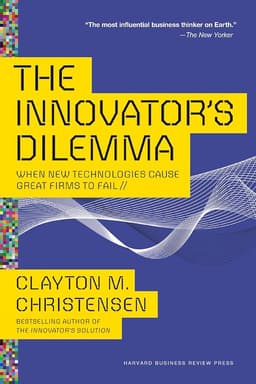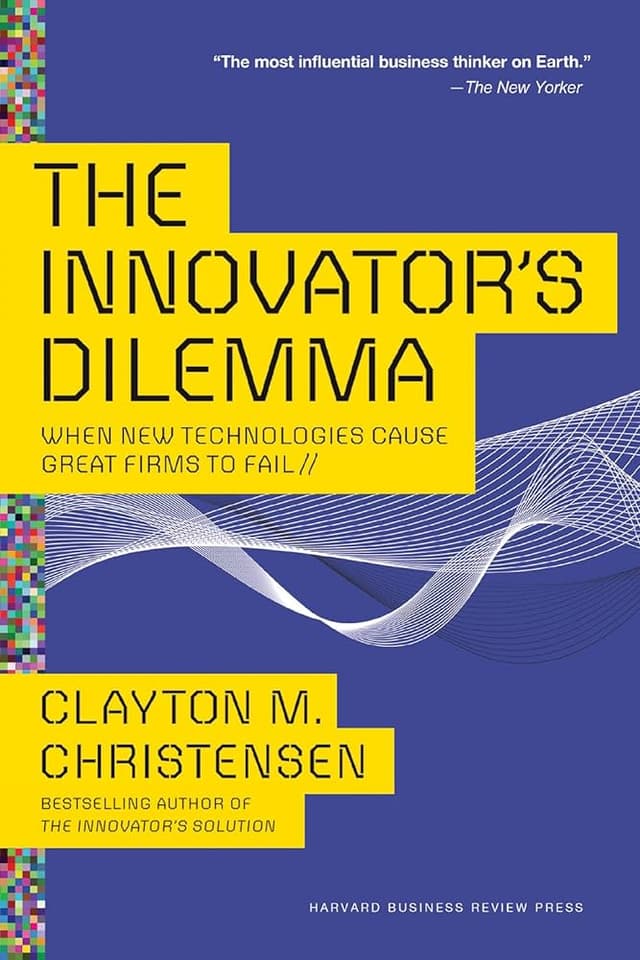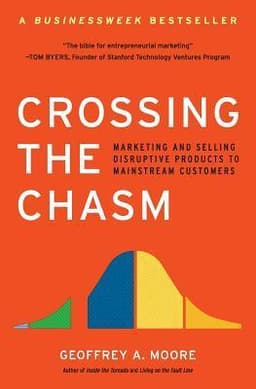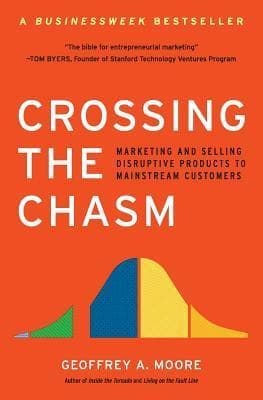
Start With Why Book Summary
How Great Leaders Inspire Everyone to Take Action
Book by Simon Sinek
Summary
Start with Why offers a powerful framework for how leaders and organizations can inspire others, build trust and loyalty, and achieve long-term success by clearly articulating and staying true to their purpose, cause or belief.
Sign in to rate
Average Rating: 4.67
1. A World That Doesn't Start With Why
Decisions Based On False Assumptions Can Lead Us Astray
Many of the decisions and assumptions we make are based on incomplete or false information. Our behavior is affected by our assumptions, even when based on incomplete information. This can lead entire companies and organizations to make poor decisions, by starting with flawed assumptions. The key is to understand the true reasons behind why we do what we do.
Section: 1, Chapter: 1
"If I Had Asked People What They Wanted, They Would Have Said A Faster Horse"
"If I had asked people what they wanted," Henry Ford said, "they would have said a faster horse."
Customers don't always know what they want. Truly innovative companies like Apple under Steve Jobs don't just respond to existing customer desires - they create new products that customers didn't even know they needed. Great leaders are able to see what most of us can't see. They give us things we would never think to ask for.
Section: 1, Chapter: 1
Manipulation Through Promotions, Fear, Aspirations And Peer Pressure
Many companies rely on manipulations to motivate customer behavior and drive sales. Typical manipulations include:
- Dropping prices through promotions and rebates
- Using fear-based messaging like "your health is at risk unless you buy our product"
- Aspirational messages that play on fantasies and insecurities
- Leveraging peer pressure by claiming "experts agree" or "everyone else is buying it"
While effective in the short term, manipulations do not breed loyalty and trust. Costs keep increasing as bigger and bigger carrots and sticks are needed over time. It's an unsustainable and stressful strategy for both companies and consumers in the long run.
Section: 1, Chapter: 2
The Price You Pay For The Money You Make
Manipulations like price drops, promotions, fear tactics and peer pressure marketing can certainly drive short-term transactions and sales. But there is always a price to pay for the money you make using these techniques:
- Costs keep increasing as you rely more and more on manipulations
- Loyalty and trust are eroded over time as customers feel tricked
- Stress increases for both company and customer in an unending struggle
- The pattern repeats in a downward spiral as manipulations are the only way forward
If you're just focused on short-term gain, manipulations can work. But to build an enduring and loyal customer base, a deeper sense of purpose and trust is needed beyond carrots and sticks. Starting with WHY provides an alternative path.
Section: 1, Chapter: 2
2. An Alternative Perspective
The Golden Circle - A Naturally Occurring Pattern
The Golden Circle is a naturally occurring pattern grounded in the biology of human decision making. The Golden Circle contains three layers:
- The outside layer is "What" - Every organization knows WHAT they do, the products they sell or services they offer.
- The middle layer is "How" - Some organizations know HOW they do what they do - their unique differentiators, proprietary process or value proposition.
- The innermost layer is "Why" - Very few organizations can clearly articulate WHY they do what they do. WHY is a purpose, cause or belief. It provides a clear answer to: Why do you get out of bed in the morning? Why should anyone care?
Most organizations communicate from the outside-in, telling people WHAT they do, HOW they are better, then expecting a behavior like a purchase. But inspired organizations start with WHY at the center, then flow outward to HOW and WHAT. When WHY is clearly communicated, WHAT you do serves as tangible proof of that belief.
Section: 1, Chapter: 3
People Don't Buy What You Do, They Buy Why You Do It
Consider an advertising message from Apple if they started with their WHAT: "We make great computers. They're user friendly, beautifully designed, and easy to use. Want to buy one?" It's not very compelling.
But Apple actually communicates from the inside out, starting with their WHY: "With everything we do, we aim to challenge the status quo. We aim to think differently. Our products are user friendly, beautifully designed, and easy to use. We just happen to make great computers. Want to buy one?"
The second version is more compelling because it starts with WHY - a purpose or belief. The products (WHAT Apple makes) serve as tangible proof of the WHY. For people who share those beliefs, Apple products become a symbol of their own values and desires.
Section: 1, Chapter: 3
Why Did The Wright Brothers Succeed Where Others Failed?
Samuel Pierpont Langley had a goal in the early 1900s to be the first man to fly an airplane. He was given $50,000 in grants, had a dream team of the best minds money could buy, and the market conditions were perfect. But we don't remember him because ultimately, he failed to get a flying machine off the ground.
On the other hand, Orville and Wilbur Wright had none of Langley's resources or funding. What they did have was a burning passion and belief - they inspired the public and their team with a dream that if they could create this flying machine, it would change the world. With an inspired team who shared their beliefs, the Wright brothers persevered through failure after failure, and ultimately did change the world.
The Wright brothers started with WHY - a purpose and cause that drove them. Langley started with WHAT - the fame and riches that success would bring. That's why today we remember the Wright brothers and have never heard of Samuel Pierpont Langley.
Section: 1, Chapter: 3
Apple And The Celery Test
Apple not only communicates from the inside out, starting with WHY, but everything they do - their products, packaging, advertising, stores, etc - all serve as further proof of their WHY. Let's apply The Celery Test - if you're buying celery and rice milk at the grocery store, it's clear that you value health. Everything you say and do "proves" that you believe in healthy eating.
Similarly, Apple believes in challenging the status quo and thinking differently. Every product they release, from computers to iPods to iPhones, challenges the conventional thinking in that industry. Apple's marketing and messaging is aspirational and iconoclastic. Even their stores, with open layouts and approachable staff, aim to make technology less intimidating. Regardless of WHAT Apple makes, it always starts with WHY - and that clear sense of purpose inspires loyalty from customers and employees alike.
Section: 1, Chapter: 3
The Limbic Brain - The Powerful "Feeling" Part Of Our Brain
The limbic brain is the middle section of our brain responsible for all our feelings, like trust and loyalty. It's also responsible for all human behavior and decision making. However, the limbic brain has no capacity for language.
When people make decisions, they rely on their limbic brain much more than the rational neo-cortex. That's why we struggle to put our feelings into words - the part of the brain that controls language is separate from the part that controls behavior.
So when a company communicates from the outside-in, starting with WHAT, they appeal only to the rational neo-cortex. But when a company starts with WHY, they talk directly to the limbic brain that controls decision making. Even if a person can't put their feelings into words, they will still "feel" right about a decision that aligns with their WHY.
Section: 1, Chapter: 4
Gaining Clarity Of WHY, Discipline Of HOW And Consistency Of WHAT
For an organization to function at its best, The Golden Circle needs to be in balance:
- Clarity of WHY: The WHY must be clearly defined within the organization. It's the leader's responsibility to make sure everyone understands WHY the company exists.
- Discipline of HOW: The guiding principles and values need to be manifested in HOW things are done. Systems, processes, and operations need to be aligned with the WHY.
- Consistency of WHAT: Everything the organization says and does has to prove what it believes. WHAT you do is the proof of WHY - the reason to buy from the company, work for the company, or invest in the company. Authenticity happens when WHAT and WHY are in balance.
Section: 1, Chapter: 5
3. Leaders Need a Following
The Sneetches And The Desire To Belong
Dr. Seuss's story The Sneetches is a perfect example of our human need to belong. The Sneetches are divided into two groups - those with stars on their bellies and those without. The ones without stars desperately want to fit in with the "in" crowd. So when the opportunity arises to get stars put on their bellies, they jump at the chance - no matter the cost.
As humans, we have an innate desire to belong to a group that shares our values and beliefs. We seek out products, people and organizations that we perceive as being like us. The feeling of "belonging" that comes from these choices provides an intangible value far beyond features and benefits.
Great companies communicate a clear WHY that attracts customers, employees and investors who believe what they believe. These organizations don't just offer value - they represent values. They provide a way for people to signal to the outside world what they believe, through the products they buy or where they choose to work.
Section: 3, Chapter: 6
Trust Is Maintained When Values And Beliefs Are Actively Managed
Trust is not born out of the rational calculations of costs and benefits - it comes from a belief that another person or organization shares your values and beliefs.
For that trust to be maintained, the values of an organization must be actively managed. The WHY must be clearly communicated, and everyone must be held accountable to living those values.
Consider Walmart - Sam Walton built a retail empire on the belief in service to people and the community. But after Walton passed, Walmart lost sight of its WHY and has become embroiled in scandals as its culture suffered. On the other hand, Costco has actively managed its culture of service, generosity and providing a living wage - and has seen the benefits in loyalty and performance.
Section: 3, Chapter: 6
Early Adopters Share Your Beliefs
The Law of Diffusion of Innovations shows that mass-market success starts with just 2.5% of "innovators", followed by 13.5% of "early adopters." These people are willing to try new things first based on a gut feeling, even if not everything is perfect.
What unites early adopters is that they share your beliefs and see the world the way you see it. They get the WHY behind what you do, and that belief is enough for them to take a chance on you before you've got all the details figured out.
Great leaders don't try to convince the majority first. They find those early adopters who believe what they believe. Once those early adopters are on board with your WHY, they become powerful evangelists to bring others along and spread your message. That's what creates the tipping point for mass-market success.
Section: 3, Chapter: 7
Dr. Martin Luther King Jr. Inspired People To Stand For What They Believed In
On August 28, 1963, over 250,000 people showed up on the Washington Mall to hear Dr. Martin Luther King Jr give his famous "I Have a Dream" speech. People came because they believed what King believed, and they followed him for themselves, not for him.
Dr. King's beliefs were bigger than any single policy or issue - they were about his vision for a future of equality and justice. He gave people a sense of purpose that was linked to his purpose. That clear and powerful WHY is what inspired so many to show up on the right day, united in a shared belief in a new and better future.
Leaders like Dr. King don't just have a vision - they have a vision that others take on as their own. By clearly communicating his WHY, Dr. King was able to inspire people to spread his cause for him, creating a true tipping point for the civil rights movement.
Section: 3, Chapter: 7
4. How To Rally Those Who Believe
Energy Excites But Charisma Inspires
There is a difference between energy and charisma in leadership. Energy, like that displayed by Microsoft CEO Steve Ballmer, can excite an audience in the moment. But that energy fades when the leader is not present. In contrast, charisma is the ability to inspire people to act even when the leader is not there.
Charisma comes from a clarity of WHY. When a leader, like Bill Gates, clearly communicates their purpose, cause or belief, it inspires people to follow them not just in the moment, but in the long run. People will continue to be inspired by a leader's charisma long after any speech or event is over.
That's because when people are inspired by a leader's WHY, they are following for themselves as much as for the leader.
Section: 4, Chapter: 8
Inspiring Leaders Embody Their Company's WHY
For an organization to maintain its WHY, the leader must embody that belief and keep it at the center of everything they do. Leaders like Steve Jobs at Apple, Bill Gates at Microsoft, Herb Kelleher at Southwest Airlines - they all served as a personification of their company's WHY.
By staying true to their WHY in every decision and communication, these leaders provided a constant reminder to everyone inside and outside the organization of WHY the company exists. They inspired by example, not just by words alone.
However, when a leader departs, it can create a dangerous vacuum if the company has not codified its WHY beyond just the leader. The key is to ingrain the WHY into every level of the organization, so the mission lives on beyond any single leader.
Section: 4, Chapter: 8
"You Don't Hire For Skills, You Hire For Attitude. You Can Always Teach Skills."
Southwest Airlines co-founder Herb Kelleher had a knack for hiring people who embodied Southwest's WHY. His famous quote, "You don't hire for skills, you hire for attitude. You can always teach skills" embodied Southwest's approach. They figured out that the people who were the best cultural fit were those who had been cheerleaders or mascots - they had an attitude of exuberance and positivity that matched Southwest's WHY of freedom and fun in air travel.
Section: 4, Chapter: 8
Speaking With Clarity And Authenticity
For a WHY to have impact, it must be communicated with clarity and authenticity. An organization amplifies its WHY through everything it says and does.
Walmart lost sight of Sam Walton's original WHY of service to people and community as it grew. Its actions (WHAT) no longer matched its intended purpose (WHY), and scandals and poor treatment of employees ensued. Virgin Atlantic, on the other hand, maintains a clarity of purpose that shines through in every product and customer touchpoint. Stunts like Richard Branson driving a tank down 5th Avenue work because they align with Virgin's WHY of shaking up established industries.
If your WHAT doesn't match your WHY, your message will be muddy and inauthentic. When WHAT and WHY are aligned through a disciplined adherence to HOW, your organization's purpose will come through loud and clear in everything you do.
Section: 4, Chapter: 10
Symbols Are Powerful Communicators Of Belief
Symbols are a tangible representation of a company or cause's beliefs. They can be much more than just a logo - they are any image, object, slogan, cultural touchpoint, etc. that captures the meaning behind WHY an organization does what it does.
Apple's famous "Think Different" ad campaign served as a symbol of Apple's belief in championing rebel thinkers who pushed boundaries. It was making a statement about its own identity and worldview.
Symbols don't get their meaning from the organization; rather the meaning comes from what the believers put into it. Harley-Davidson tattoos are earned symbols of belief in Harley's WHY - a sense of independence and American freedom.
Section: 4, Chapter: 10
5. The Biggest Challenge is Success
Success Can Be The Greatest Challenge To Maintaining Your WHY
It's a great irony that achieving success can often be what causes an organization to lose sight of the very purpose, cause and belief that made them successful in the first place. As organizations grow, several things happen:
- The founder can no longer be involved in every decision, so the clarity of WHY starts to dilute as others make choices
- Outside pressures from shareholders, media, competitors, etc. can distract from the original purpose
- Early passion fades as success feels less exciting and more like "business as usual"
Section: 5, Chapter: 11
Achievement Versus Success
There is an important distinction between achievement and success:
- Achievement is about hitting a goal, milestone, metric. It's focused on WHAT you attain or accomplish.
- Success is a feeling or state of being. It's about WHY you do what you do and feeling fulfilled by it.
Many high achieving people are surprised to realize they don't feel successful despite their outward accomplishments. That's because achievement alone doesn't satisfy our deeper desire for meaning and purpose.
Achievement comes from pursuing and attaining WHAT you want. Success comes from clearly knowing and staying true to WHY you want it. Organizations that drift away from their WHY may continue to achieve, but they will cease to inspire the success that comes from a clarity of purpose.
Section: 5, Chapter: 11
Maintaining Your WHY Takes Consistent Effort And Accountability
It's one thing to have a clear sense of WHY at the outset, but the true challenge is maintaining that clarity and consistency of purpose as the organization grows and evolves.
- Put your WHY into writing. Make it a mantra that is communicated over and over from leadership.
- Codify your HOWs into guiding principles that align to the WHY. Make them actionable and hold everyone accountable to them.
- Build the WHY into the hiring process. Hire people who believe what you believe and will be culture adds, not just skill adds.
- Celebrate and showcase actions that exemplify the WHY. Reinforce the behaviors you want to see more of.
Section: 5, Chapter: 12
The Origins Of The WHY
An individual or organization's WHY is not something that's created or invented - it's discovered. Your WHY is a product of your upbringing, your influences, your life experience.
Some find their WHY early in life, like the Wright Brothers' belief in flight and Bill Gates' belief in the democratization of computers. Others discover it through the ups and downs of their career journeys and life experience, like Southwest Airlines co-founder Herb Kelleher realizing his passion for championing the common man.
Regardless of when you find it, authenticity to your WHY will always come from looking at the sum total of where you've been and what has shaped you. You can't fake your WHY or try to co-opt someone else's. Authenticity to purpose can only come from an honest examination of the experiences and beliefs that made you who you are.
Section: 6, Chapter: 13
Compete Against Yourself
"When you compete against everyone else, no one wants to help you. But when you compete against yourself, everyone want to help you."
Cross country runner Ben Comen, who has cerebral palsy, is not the fastest runner on his high school team. But he is the only runner who, despite finishing last in every race, has a crowd of people waiting at the finish line to cheer him on.
Ben is not competing with the other runners; he's competing with himself to finish the race and achieve his personal best. His sense of WHY - his larger purpose beyond winning - inspires others who want to see him succeed. In turn, Ben draws strength from the support of others who believe in his WHY.
Section: 6, Chapter: 14
Related Content


The Innovator's Dilemma Book Summary
Clayton M. Christensen
"The Innovator's Dilemma" unveils a paradoxical truth: successful companies are often perfectly positioned to fail. Established firms can become blindsided by disruptive technologies that reshape industries. This book offers a framework for navigating these disruptive threats, urging companies to embrace new market opportunities and transform themselves to thrive in the face of inevitable change.
"The Innovator's Dilemma" unveils a paradoxical truth: successful companies are often perfectly positioned to fail. Established firms can become blindsided by disruptive technologies that reshape industries. This book offers a framework for navigating these disruptive threats, urging companies to embrace new market opportunities and transform themselves to thrive in the face of inevitable change.
Business
Innovation
Management


Crossing the Chasm Book Summary
Geoffrey Moore
"Crossing the Chasm" unveils the hidden challenges of launching disruptive technologies and provides a proven roadmap for navigating the treacherous gap between early adopters and mainstream markets, enabling companies to achieve market leadership and sustainable growth.
"Crossing the Chasm" unveils the hidden challenges of launching disruptive technologies and provides a proven roadmap for navigating the treacherous gap between early adopters and mainstream markets, enabling companies to achieve market leadership and sustainable growth.
Business
Management
Technology

